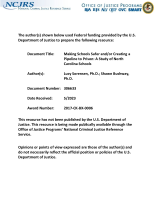Drug possession
Assessing the Impact of Dade County's Felony Drug Court, Final Report
Assessing the Impact of Dade County's Felony Drug Court: Executive Summary
Experimental Evaluation of Drug Testing and Treatment Interventions for Probationers in Maricopa County, Arizona
Criminal Violence and Incapacitation: Wishes and Realities
Violence As Regulation and Social Control in the Distribution of Crack (From Drugs and Violence: Causes, Correlates, and Consequences, P 8-43, 1990, Mario De La Rosa, Elizabeth Y Lambert, Bernard Gropper, eds. -- See NCJ-128781)
Assessment of Methods Used by State and Local Governments to Estimate Drug Abuse Levels: Summary
Serious Drug Abuser Scale Based on Manhattan Arrestees (1987- 1991)
Race and Rationality Revisited: An Empirical Examination of Differential Travel Patterns to Acquire Drugs Across Geographic Contexts
Cannabis liberalization policies and trends in cannabis-related school-based discipline: Examining sociodemographic disparities in Massachusetts
Making Schools Safer and/or Creating a Pipeline to Prison: A Study of North Carolina Schools
Revisiting Neighborhood Context and Racial Disparities in Drug Arrests Under the Opioid Epidemic
Examining the Effect of Oregon’s Measure 110 on Racial and Ethnic Disparities in Criminal Justice Outcomes
AN EXEMPLARY PROJECT - JUVENILE DIVERSION THROUGH FAMILY COUNSELING: A PROGRAM FOR THE DIVERSION OF STATUS OFFENDERS IN SACRAMENTO COUNTY, CALIFORNIA
Opioids, Race, Context, and Journeys to Crime: Analyzing Black-White Differences in Travel Associated With Opioid Possession Offenses
Objective Method for Presumptive Field-Testing of Illicit Drug Possession Using Centrifugal Microdevices and Smartphone Analysis
School Safety Considerations for Distinct Student Populations - Breakout Session, NIJ Virtual Conference on School Safety
On February 16-18, 2021, the National Institute of Justice hosted the Virtual Conference on School Safety: Bridging Research to Practice to Safeguard Our Schools. This video includes the following presentations:
See the YouTube Terms of Service and Google Privacy Policy



